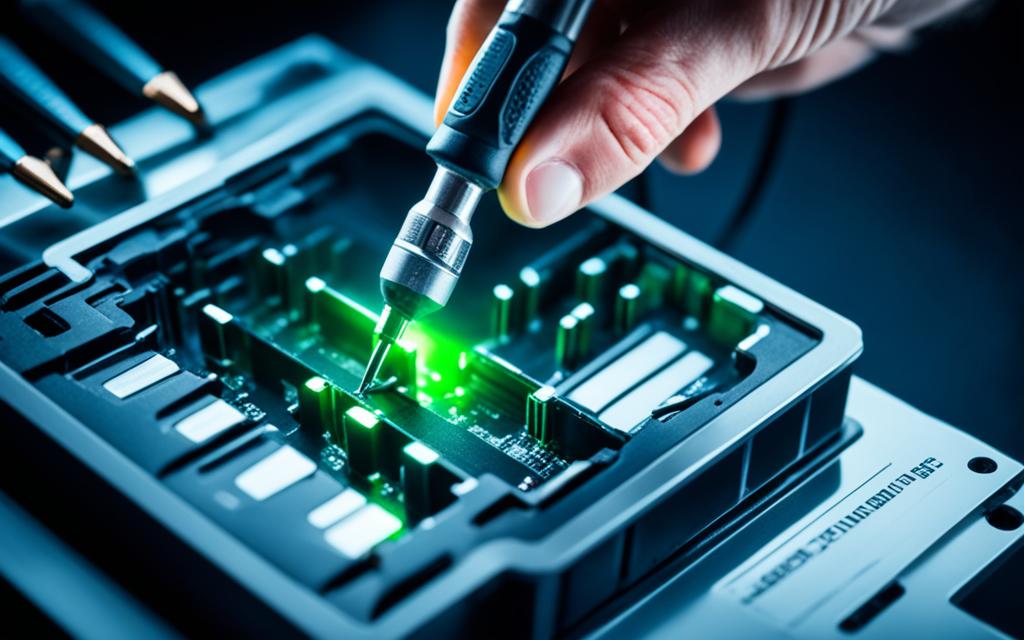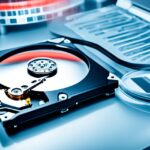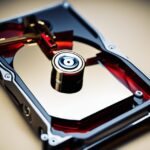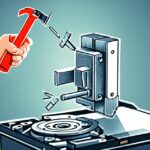Table of Contents
In the tech world, knowing how to handle bad blocks on a hard drive is essential. Bad blocks, or bad sectors, can lead to big problems, like losing important data and making your system unstable. It’s important to learn how to recover a hard drive to prevent these issues.
Tools like Windows CHKDSK make it easy to find and fix these bad spots. Knowing how to act fast in fixing them is key. This can stop your hard drive from failing and keep your data safe. For step-by-step methods on fixing bad blocks, check out this link here1.
Key Takeaways
- Bad blocks can cause serious data loss and system instability.
- Employing tools like Windows CHKDSK helps in the repair of soft bad sectors.
- Physical damage requires more intensive recovery solutions compared to logical errors.
- Regular backups are vital to safeguard against data loss.
- AOMEI Partition Assistant is highly effective for fixing bad sectors with its user-friendly interface.
- Signs of potential hard black failures include unusual noises and error messages during file access.
- Acting quickly when bad blocks are detected can prevent further complications.
Understanding Bad Blocks on Hard Drives
Knowing about bad blocks on hard drives is key if you want to keep your data safe. A hard drive block is the smallest data storage unit, usually 512 bytes, and it’s vital for the disc’s storage2. Bad blocks are these units that can cause problems, so understanding them is important.
What is a Hard Drive Block?
A hard drive block helps organise data storage. These blocks let devices read and write data smoothly. Knowing about different types of storage units is crucial, especially when dealing with bad blocks.
The Difference Between Blocks and Sectors
Blocks and sectors play different roles in storing data. Blocks are about the data’s logic structure, while sectors are specific physical spots on the disk where data gets read or written3. Bad sectors can mess up a whole cluster, causing a lot of data trouble. New tech like GPT helps systems handle big drives better today3.
| Term | Definition |
|---|---|
| Hard Drive Block | The smallest unit of data storage, typically 512 bytes. |
| Sector | A specific physical location on the hard disk used for reading or writing data. |
| Cluster | Management unit for space within file systems, often consisting of multiple blocks. |
Types of Bad Blocks
There are two main types of bad blocks we need to know about for better data management. These bad blocks can cause serious data storage errors, harming the performance of the whole system. We refer to them as hard bad sectors and soft bad sectors. They differ in their causes and the problems they present.
Hard Bad Sectors
Hard bad sectors come into being due to physical harm to the hard drive. This could be from dropping it or exposing it to harmful environments. They signal that part of the disk can no longer be trusted to save data. That might happen, for example, if a laptop is dropped, leading to crucial failures that need quick action4. These areas are often spotted when the hard drive is made or during routine checks. They’re then marked as unuseable5.
In newer devices, there’s a way to handle these sectors to keep the disk working well. This involves replacing the bad sectors with spare ones through a process called sector sparing4.
Soft Bad Sectors
Soft bad sectors, on the other hand, are born from errors in the operating system or problems with applications. They might appear after an unexpected shutdown, messing with a block’s data. This leads to the block being labelled as bad4. But unlike their hard counterparts, it’s possible to fix soft bad sectors. You can use tools that look for and mend these errors.
Programs like CHKDSK on Windows are great for this. They check for identify bad sectors and might fix them, helping to limit their negative impact on data storage5.
How to Fix a Bad Block on a Hard Drive
Fixing bad blocks on a hard drive is crucial for its performance and to avoid losing data. You can use the Windows Error Checking tool, the CHKDSK command, and third-party software. All these methods are effective in repairing bad blocks.
Using Windows Error Checking Utility
The Windows Error Checking Tool is easy to use. Right-click the drive, click ‘Properties’, then go to ‘Tools’. Here, you’ll see ‘Error-checking’. Running this checks and fixes soft bad sectors, often caused by software issues. Using this tool regularly keeps your hard drive healthy and prevents failure.
Running the CHKDSK Command
Use the CHKDSK command to solve hard drive problems. Open a command prompt as an admin and type chkdsk C: /f, changing “C” to your drive letter. This finds and corrects errors, and tries to fix bad sectors. It’s really useful for the common “Device \Device\Harddisk0\DR0 has a Bad Block” issue. If bad blocks appear, consider more tests or replacing the drive (source)6.
Employing Third-Party Software
Software utilities for data repair offer more features for fixing drives. They have step-by-step guides, making them easy for anyone to use. These tools can deeply scan and tell soft from hard bad sectors. Always pick trusted software to prevent further harm. If problems are still there, you might need to test the disk surface for physical bad sectors (source)1.
When to Seek Professional Help
Knowing when to get professional help is crucial for hard drive issues. There are signs that show your hard drive might be failing. These signs require an expert’s input.
Signs of Physical Damage
- Unusual noises, like clicking or grinding, suggest damage.
- Persistent read/write errors block access to data.
- System crashes and frequent blue screens indicate failure.
If you notice these symptoms, getting help is wise. Data recovery specialists can be vital for bad blocks. Data recovery reports note 172,256 instances of hard drive failures. This shows how common these issues are7. Even a single bad sector on a 650 GB drive needs expert attention8. Ubuntu 14.04 can make diagnosis difficult, so trust skilled technicians8.
Data Recovery Services
Professional data recovery services offer solutions for various problems. They use special tools and work in clean rooms to keep the recovery process safe. Software like Wondershare Recoverit and DiskGenius can get back important files7. Bad blocks stop you from accessing your data, so these professionals help you have a better chance at retrieving it.
It’s crucial to spot hard disk damage signs early. As bad sectors increase, they can make the situation worse. This affects your data’s accessibility and safety. Seek help quickly to protect your important files879.
Preventing Future Bad Blocks
To make your hard drive last longer and work better, it’s key to take steps early. Knowing how to back up your data and keep your hard drive in good shape increases data safety and health.
Regular Backups
Backups are key to protecting your important data. It’s smart to have an automatic backup every day. Weekly backups often miss problems that can happen in between10. Use a trusted tool like MiniTool ShadowMaker for automatic, ongoing backups. This helps avoid data loss from bad sectors or other drive problems11.
Optimising Your Hard Drive
To keep your hard drive working well, regular care is important. Making sure it’s defragmented, kept cool, and safe from hits helps keep it running smoothly. You should also use tools like CHKDSK. They check your disk for bad spots and fix them to protect your data5.
Conclusion
To fix bad blocks, it’s crucial to know about hard and soft bad sectors. Hard bad sectors come from physical damage. Soft bad sectors, however, can often be fixed with software. Watching for warning signs like odd noises or slow performance helps catch problems early. This protects your data’s integrity12.
Regular checks for bad sectors are key to extending your hard drive’s life. Avoid improper shutdowns too. Tools like CHKDSK and programs like DiskGenius let users tackle issues before they get worse. Plus, always have a backup plan to avoid losing data during repairs13.
Taking care of your digital storage is vital for keeping your data safe. Staying alert and doing regular check-ups protects your valuable info. It also builds your confidence in managing hard drive problems.
Q: Can bad blocks be repaired completely?
What are bad blocks, and why are they important to fix?
Bad blocks, also called bad sectors, are damaged areas on a hard drive. They can cause loss of data and make your computer unstable. Fixing them helps keep your data safe and improves your computer’s performance.
How can I identify if my hard drive has bad blocks?
Keep an eye out for signs like strange noises, errors during read/write operations, or your system frequently crashing. Tools like Windows CHKDSK can check for bad sectors.
What tools can I use to repair bad blocks?
Windows Error Checking utility, the CHKDSK command, or good third-party software can be used. Each method is useful for fixing bad sectors.
What is the difference between hard bad sectors and soft bad sectors?
Hard bad sectors mean the hard drive is physically damaged. Soft bad sectors happen because of software issues. Knowing which type you have helps in fixing them the right way.
When should I consider professional data recovery services?
Look for signs of damage like loud clicking noises or your computer crashing often. Professionals have special tools and know-how to safely recover data from damaged drives.
How can I prevent bad blocks from occurring in the future?
Always back up your data regularly. Performing routine hard drive maintenance and avoiding physical damage can lower the chance of bad sectors.
Soft bad sectors can usually be fixed with software. However, hard bad sectors mean the drive is permanently damaged. Watching your drive’s health and fixing issues promptly can lessen the effects of bad blocks.
Source Links
- https://www.easeus.com/disk-copy/clone-resource/repair-a-bad-sector-in-windows-10-8-7.html – Repair Bad Sector: How to Fix Bad Sectors on HDD in Windows 10/8/7
- https://www.auslogics.com/en/articles/how-to-fix-bad-sectors-on-a-hard-drive/ – How to Fix Bad Sectors on a Hard Drive
- https://superuser.com/questions/1596765/what-is-the-difference-between-a-bad-block-and-a-bad-sector – What is the difference between a bad block and a bad sector?
- https://www.geeksforgeeks.org/bad-block-in-operating-system/ – Bad Block in Operating system – GeeksforGeeks
- https://www.techtarget.com/searchstorage/definition/bad-block – What Is a Bad Block? | Definition from TechTarget
- https://www.partitionwizard.com/partitionmagic/the-device-deviceharddisk0dr0-has-a-bad-block.html – Solved: the Device DeviceHarddisk0DR0 has a Bad Block – MiniTool Partition Wizard
- https://repairit.wondershare.com/windows-tips/bad-block-on-hard-drive-repair.html – How to Fix Bad Block on Hard Drive Repair
- https://superuser.com/questions/988413/if-a-hard-drive-develops-a-bad-sector-should-it-be-replaced – If a hard drive develops a bad sector, should it be replaced?
- https://botrecuperacaodedados.com/what-is-bad-block-on-a-disk/ – What is Bad Block on a disk, what can cause it and how to recover?
- https://superuser.com/questions/1441306/how-to-prevent-bad-sectors – How to prevent bad sectors?
- https://www.minitool.com/backup-tips/bad-sectors-on-hard-drive.html – What to Do If I Find Bad Sectors on Hard Drive in Windows 10/8/7? – MiniTool
- https://www.diskgenius.com/how-to/bad-sector-repair-software.php – How to Check and Repair Bad Sectors for Hard Drives or USB Drives?
- https://www.easeus.com/partition-master/repair-bad-sectors-on-external-hard-drive.html – How to Fix Bad Sectors on External Hard Drive [Full Guide]








